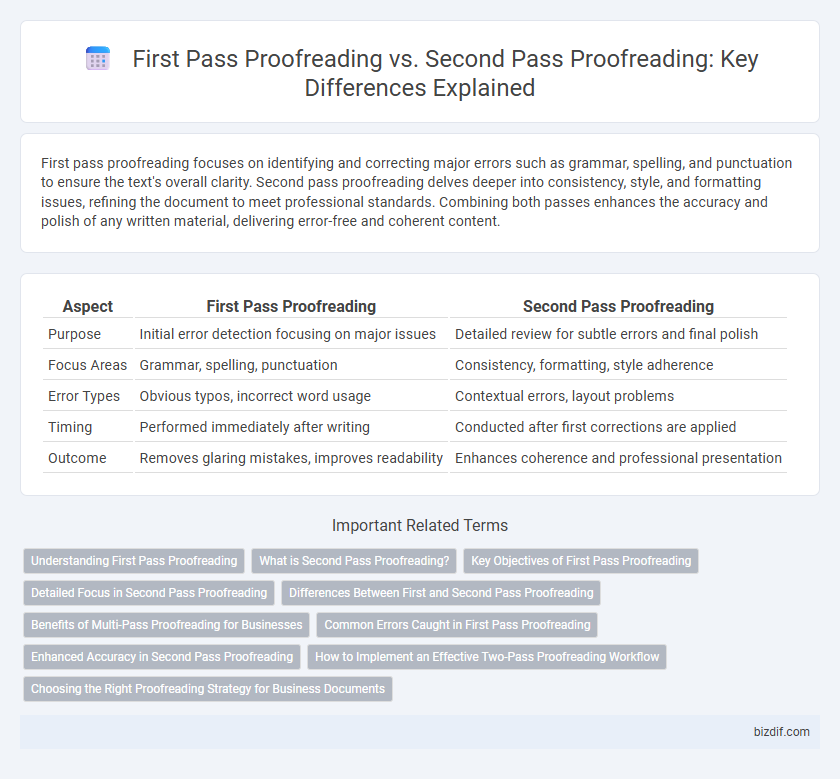First pass proofreading focuses on identifying and correcting major errors such as grammar, spelling, and punctuation to ensure the text's overall clarity. Second pass proofreading delves deeper into consistency, style, and formatting issues, refining the document to meet professional standards. Combining both passes enhances the accuracy and polish of any written material, delivering error-free and coherent content.
Table of Comparison
| Aspect | First Pass Proofreading | Second Pass Proofreading |
|---|---|---|
| Purpose | Initial error detection focusing on major issues | Detailed review for subtle errors and final polish |
| Focus Areas | Grammar, spelling, punctuation | Consistency, formatting, style adherence |
| Error Types | Obvious typos, incorrect word usage | Contextual errors, layout problems |
| Timing | Performed immediately after writing | Conducted after first corrections are applied |
| Outcome | Removes glaring mistakes, improves readability | Enhances coherence and professional presentation |
Understanding First Pass Proofreading
First Pass Proofreading involves an initial review of the text to identify and correct obvious errors in grammar, spelling, and punctuation, ensuring the document meets basic linguistic accuracy. This stage prioritizes surface-level issues without deeply engaging with content consistency or style refinement. Understanding this phase is critical for streamlining the editing workflow and establishing a polished foundation before advancing to more detailed Second Pass Proofreading.
What is Second Pass Proofreading?
Second pass proofreading involves a detailed review of a document after the initial correction phase to catch any overlooked errors and ensure consistency in language, tone, and formatting. This stage focuses on refining grammar, punctuation, spelling, and stylistic elements that may have been missed during the first pass. The goal of second pass proofreading is to deliver a polished, error-free final version that meets high-quality standards.
Key Objectives of First Pass Proofreading
First Pass Proofreading primarily focuses on identifying and correcting glaring errors such as spelling, punctuation, and formatting inconsistencies to ensure the document's basic accuracy and presentation. This stage targets surface-level issues that can distract the reader or undermine the document's professionalism. Emphasizing clarity and coherence, First Pass Proofreading sets the foundation for subsequent, more detailed reviews like Second Pass Proofreading, which delve into content accuracy and stylistic nuances.
Detailed Focus in Second Pass Proofreading
Second pass proofreading emphasizes meticulous attention to detail, focusing on catching subtle errors such as punctuation inconsistencies, formatting issues, and typographical mistakes that first pass proofreading may overlook. It ensures the text adheres to style guides and maintains logical flow by reviewing sentence structure and clarity. This thorough approach guarantees a polished, error-free final document ready for publication or submission.
Differences Between First and Second Pass Proofreading
First Pass Proofreading primarily targets surface-level errors such as spelling, punctuation, and basic grammar mistakes, ensuring the text is free of obvious typographical issues. Second Pass Proofreading involves a deeper review, focusing on consistency, formatting, and contextual accuracy, including checking facts and adherence to style guidelines. These distinct stages optimize the overall quality by addressing different layers of error and ensuring a polished final document.
Benefits of Multi-Pass Proofreading for Businesses
Multi-pass proofreading enhances accuracy by catching errors that a single review might miss, significantly reducing the risk of costly mistakes in business communications and marketing materials. This method ensures consistency in tone, style, and terminology, fostering a professional brand image and improving client trust. By implementing first and second-pass proofreading, businesses optimize content quality, streamline editorial workflows, and minimize the need for extensive revisions post-publication.
Common Errors Caught in First Pass Proofreading
First pass proofreading primarily catches common errors such as spelling mistakes, punctuation errors, and obvious grammatical issues, ensuring the text's basic clarity and correctness. It also identifies inconsistencies in formatting, capitalization, and simple typographical errors that can disrupt the reader's understanding. By addressing these fundamental mistakes early, first pass proofreading lays the groundwork for a polished and professional final document.
Enhanced Accuracy in Second Pass Proofreading
Second pass proofreading significantly enhances accuracy by focusing on subtle errors missed during the first pass, such as grammatical inconsistencies, punctuation mistakes, and formatting issues. This stage involves a more detailed review, ensuring the text meets high editorial standards and maintains consistency throughout the document. Employing a second pass proofreading process reduces the likelihood of overlooked mistakes, resulting in a polished and professional final product.
How to Implement an Effective Two-Pass Proofreading Workflow
Implement an effective two-pass proofreading workflow by first focusing on content accuracy, grammar, and punctuation during the initial pass to catch major errors and inconsistencies. The second pass should concentrate on formatting, layout, and typographical issues to ensure the document's visual and structural integrity. Utilizing specialized tools and maintaining checklists for each pass enhances precision and streamlines the review process.
Choosing the Right Proofreading Strategy for Business Documents
First pass proofreading focuses on catching major errors such as typos, grammatical mistakes, and formatting inconsistencies in business documents, ensuring clarity and professionalism. Second pass proofreading dives deeper, verifying facts, refining tone, and checking document coherence to enhance overall quality and accuracy. Selecting the appropriate strategy depends on the document's purpose, complexity, and the desired level of precision for effective corporate communication.
First Pass Proofreading vs Second Pass Proofreading Infographic

 bizdif.com
bizdif.com